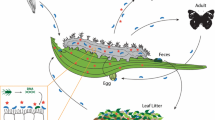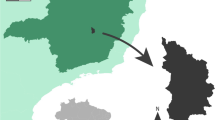Abstract
Symbiotic microorganisms that live intimately associated with terrestrial plants affect both the quantity and quality of resources1,2, and thus the energy supply to consumer populations at higher levels in the food chain. Empirical evidence on resource limitation of food webs points to primary productivity as a major determinant of consumer abundance and trophic structure3,4,5,6. Prey quality plays a critical role in community regulation7,8. Plants infected by endophytic fungi are known to be chemically protected against herbivore consumption9,10,11. However, the influence of this microbe–plant association on multi-trophic interactions remains largely unexplored. Here we present the effects of fungal endophytes on insect food webs that reflect limited energy transfer to consumers as a result of low plant quality, rather than low productivity. Herbivore–parasite webs on endophyte-free grasses show enhanced insect abundance at alternate trophic levels, higher rates of parasitism, and increased dominance by a few trophic links. These results mirror predicted effects of increased productivity on food-web dynamics12. Thus ‘hidden’ microbial symbionts can have community-wide impacts on the pattern and strength of resource–consumer interactions.


Similar content being viewed by others
References
Gehring, C. A. & Whitham, T. G. Interactions between aboveground herbivores and mycorrhyzal mutualists of plants. Trends Ecol. Evol. 9, 251–255 (1994).
van der Heijden, M. G. A. et al. Mycorrhizal fungal diversity determines plant biodiversity, ecosystem variability and productivity. Nature 396, 69–72 (1998).
Wootton, J. T. & Power, M. E. Productivity, consumers, and the structure of a river food chain. Proc. Natl Acad. Sci. USA 90, 1384–1387 (1993).
Kaunzinger, C. M. K. & Morin, P. J. Productivity controls food-chain properties in microbial communities. Nature 395, 495–497 (1998).
Mikola, J. & Setälä, H. Productivity and trophic-level biomasses in a microbial-based solid food web. Oikos 82, 158–168 (1998).
Hulot, F. D., Lacroix, G., Lescher-Moutoué, F. & Loreau, M. Functional diversity governs ecosystem response to nutrient enrichment. Nature 405, 340–344 (2000).
Leibold, M. A., Chase, J. M., Schurin, J. B. & Downing, A. L. Species turnover and the regulation of trophic structure. Annu. Rev. Ecol. Syst. 28, 467–494 (1997).
Abrams, P. A. Effects of increased productivity on the abundance of trophic levels. Am. Nat. 141, 351–371 (1993).
Clay, K. Fungal endophytes of grasses. Annu. Rev. Ecol. Syst. 21, 275–297 (1990).
Dahlman, D. L., Eichenseer, H. & Siegel, M. R. in Microbial Mediation of Plant-Herbivore Interactions (eds Barbosa, P., Krischik, V. A. & Jones, C. G.) 227–252 (John Wiley, New York, 1991).
Breen, J. P. Acremonium endophyte interactions with enhanced plant resistance to insects. Annu. Rev. Entomol. 39, 401–423 (1994).
Oksanen, L., Fretwell, S. D., Arruda, J. & Niemelä, P. Exploitation ecosystems in gradients of primary productivity. Am. Nat. 118, 240–261 (1981).
Hairston, N. G., Smith, F. E. & Slobotkin, L. B. Community structure, population control, and competition. Am. Nat. 94, 421–425 (1960).
Price, P. W. et al. Interaction among three trophic levels: influence of plants on interactions between insect herbivores and natural enemies. Annu. Rev. Ecol. Syst. 11, 41–65 (1980).
Hunter, M. D. & Price, P. W. Playing chutes and ladders: heterogeneity and the relative roles of bottom-up and top-down forces in natural communities. Ecology 73, 724–732 (1992).
Osenberg, C. W. & Mittelbach, G. G. in Food Webs: Integration of Patterns and Dynamics (eds Polis, G. & Winemiller, K. O.) 134–148 (Chapman & Hall, New York, 1996).
DeAngelis, D. L. Dynamics of Nutrient Cycling and Food Webs (Chapman & Hall, London, 1992).
Müller, C. B., Adriaanse, I. C. T., Belshaw, R. & Godfray, H. C. J. The structure of an aphid-parasitoid community. J. Anim. Ecol. 68, 346–370 (1999).
Holt, R. D. Predation, apparent competition and the structure of prey communities. Theor. Pop. Biol. 12, 197–229 (1977).
Holt, R. D. & Lawton, J. H. Apparent competition and enemy-free space in insect host-parasitoid communities. Am. Nat. 142, 623–645 (1993).
Chaneton, E. J. & Bonsall, M. B. Enemy-mediated apparent competition: empirical patterns and the evidence. Oikos 88, 380–394 (2000).
McCann, K., Hastings, A. & Huxel, G. Weak trophic interactions and the balance of nature. Nature 395, 794–798 (1998).
Barker, G. M. & Addison, P. J. Influence of Clavicipitaceous endophyte infection in ryegrass on development of the parasitoid Microctonus hyperodae Loan (Hymenoptera: Braconidae) in Listronotus bonariensis (Kuschel) (Coleoptera: Curculionidae). Biol. Contr. 7, 281–287 (1996).
Bultman, T. L., Borowicz, K. L., Schneble, R. M., Coudron, T. A. & Bush, L. P. Effect of a fungal endophyte on the growth and survival of two Euplectrus parasitoids. Oikos 78, 170–176 (1997).
Dobson, A. P. & Crawley, M. J. Pathogens and the structure of plant communities. Trends Ecol. Evol. 9, 393–398 (1994).
Grime, J. P., MacKey, J. M. L., Hillier, S. H. & Read, D. J. Floristic diversity in a model system using experimental microcosms. Nature 328, 420–422 (1987).
Clay, K. & Holah, J. Fungal endophyte symbiosis and plant diversity in successional fields. Science 285, 1742–1744 (1999).
Latch, G. C. M., Christensen, M. J. & Hickson, R. E. Endophytes of annual and hybrid ryegrasses. New Zeal. J. Agr. Res. 31, 57–63 (1988).
Alatalo, R. V. Problems in the measurement of evenness in ecology. Oikos 37, 199–204 (1981).
Magurran, A. E. Ecological Diversity and its Measurement (Princeton Univ. Press, New Jersey, 1988).
Acknowledgements
We thank A. Austin, M. Bonsall, A. Bourke, C. Godfray, D. Golombek, T. H. Jones, N. Mazía, R. Pettifor, S. Power, P. Roset, S. Semple and M. Vila-Aiub for comments on the manuscript; E. Demartin, P. Gundel and M. Rabadan for field assistance; R. Belshaw and F. van Veen for helping with parasitoid identification; and C. Godfray for constructing the web diagrams. This study was funded by grants from the Agencia Nacional de Promoción Cientifica y Tecnológica of Argentina and Fundación Antorchas.
Author information
Authors and Affiliations
Corresponding authors
Rights and permissions
About this article
Cite this article
Omacini, M., Chaneton, E., Ghersa, C. et al. Symbiotic fungal endophytes control insect host–parasite interaction webs. Nature 409, 78–81 (2001). https://doi.org/10.1038/35051070
Received:
Accepted:
Issue Date:
DOI: https://doi.org/10.1038/35051070
- Springer Nature Limited
This article is cited by
-
Arbuscular mycorrhizal fungi make endophyte-induced plant volatiles perceptible
Symbiosis (2023)
-
Genetic Covariation Between the Vertically Transmitted Endophyte Epichloë canadensis and Its Host Canada Wildrye
Microbial Ecology (2023)
-
Environmental stress determines the colonization and impact of an endophytic fungus on invasive knotweed
Biological Invasions (2022)
-
Does Epichloë Endophyte Enhance Host Tolerance to Root Hemiparasite?
Microbial Ecology (2021)





